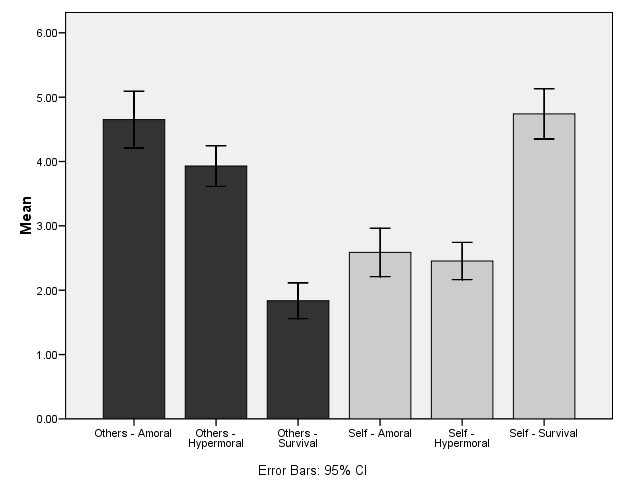Should We Tell Our Students That We Think Both Liberalism and Conservatism Are Valuable?
For the past few years, I’ve been assigning “Planet of the Durkheimians,” an article on liberalism and conservatism by Jonathan Haidt and Jesse Graham, in my MBA business ethics courses at Rutgers.
In one class in particular, I went into depth explaining the article’s vision of an alternative world in which communitarian traditionalists control the academy and find liberalism psychologically deviant. In doing so, I made it clear to my students that I believed in the complementarity of liberalism and conservatism as contrasting positions that together have great value in creating a well-functioning social system.
Most semesters, though, I’ve taken more of a “just the facts, ma’am” approach. I focus on Haidt and Graham’s data on differences between liberals and conservatives, raise questions as to whether either side is really committed to foundational principles (are conservatives communitarian and traditionalist given their support of markets?; are liberals skeptics about loyalty given their support of unionism?), and pose the question of whether both liberalism and conservatism have value as an open one to which negative as well as positive answers are possible.
Recently, I drew on my teaching experiences to write “Modeling Moral Education about Political Ideology” for the Society for Business Ethics conference this summer in Montreal. The paper uses hypothetical teacher-student dialogues and game theory to reflect on a number of questions, including whether it makes sense for a teacher to use Haidt and Graham and other research as a springboard for the teacher to assert a personal belief in the value of both liberalism and conservatism and of mutual respect between the sides.
Readers interested in additional substantive issues associated with teaching about political ideology–for example, how does teaching John Jost’s theory of conservatism as system justification differ from teaching Haidt and Graham?–as well as in the game-theoretic nuances–one-shot versus repeat games, accounting for altruistic preferences, the calculation of Nash equilibria, etc.–are invited to check out the paper and the 2 x 2 matrices in the style of my college professor Thomas Schelling. Here, I’ll focus on the major themes rather than the nuances.
The first key point in the game-theoretic analysis is that a student as well as the teacher makes a decision. Just as the teacher decides whether to avow his or her belief in complementarity, the student assigned the pro-complementarity Haidt and Graham article decides whether or not to commit to the article. Commitment involves not only reading the material but also attempting to absorb its argument and to take that argument seriously–a process that may lead to success but that may also be attended by failure at one step or another. Noncommitment by contrast involves avoidance of engagement–the student may be able to answer questions about Haidt and Graham’s data and argument entirely competently, but chooses not to be absorbed by the article and the theme of complementarity.
The second key game-theoretic point is that the psychic rewards for both the teacher and the student depend to a great degree on what the other does. If the teacher goes “all in” by committing and the student does likewise, there is an inspiring if also uncertain prospect that the sacred fire of knowledge will burn at its brightest–but if the student avoids commitment, there is an unpleasant clash between the values of the “all in” teacher and the “just the facts” student that can be reasonably described as the worst outcome for both.
The key to the solution of the game between a teacher and a student who both choose whether to commit or not lies in the shared incentive of both sides to avoid the clash of values outcome. For his or her part, a teacher worried about that happening has a strong reason to avoid “all in” in favor of backing off and taking a “just the facts” approach. Similarly, a student concerned about avoiding the breakdown outcome has a good reason to overcome work aversion and risk aversion in favor of committing to the reading and its theme of complementarity.
In the game, neither the teacher nor the student has a dominant strategy, which means that both should play a randomized strategy. With the payoff numbers I assigned, the teacher should follow a “just the facts” approach 5/6 of the time, while the student should commit to the material 3/4 of the time. Randomized commitment sounds odd and unrealistic–but the 1/6 figure for the teacher going “all in” corresponds pretty closely to the proportion of the time I’ve wound up avowing my own belief in complementarity between liberalism and conservatism.
The take-away: It makes sense in terms of game theory and its tough-minded rational choice assumptions as well as in terms of civility for a teacher and a student to generally accommodate the feelings of the other—the teacher by rarely pushing a personal belief that both liberalism and conservatism are valuable, and the students by most of the time trying to grasp that position anyway.
A final note: I’d like to believe the 3/4 figure for students committing corresponds well to the proportion of my business ethics students who sincerely try to absorb the complementarity position in Haidt and Graham, whether or not they ultimately succeed in doing so–there however I must admit to lacking the data to know how well the game-theoretic model of moral education corresponds to real-life student behavior!
-Wayne Eastman


